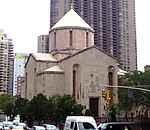Kips Bay Towers

Kips Bay Towers is a large two-building condominium complex in the Kips Bay neighborhood of Manhattan with a total of 1,118 units. The complex was designed by architects I.M. Pei and S. J. Kessler, with the involvement of James Ingo Freed, in the brutalist style and completed in 1965. The project was developed by Webb & Knapp.The complex occupies an area of three city blocks, or approximately 7.5 acres (3.0 ha), bounded by First and Second avenues and East 30th and 33rd streets. The complex includes two residential high-rise buildings each with 20 floors. Additionally, there is a three-acre private garden between the two towers featuring landscaped lawns as well as recreational spaces. Kips Bay Towers is home to more than 4,000 residents.
Excerpt from the Wikipedia article Kips Bay Towers (License: CC BY-SA 3.0, Authors, Images).Kips Bay Towers
East 33rd Street, New York Manhattan
Geographical coordinates (GPS) Address Website External links Nearby Places Show on map
Geographical coordinates (GPS)
| Latitude | Longitude |
|---|---|
| N 40.742777777778 ° | E -73.975833333333 ° |
Address
Kips Bay Tower North
East 33rd Street
10016 New York, Manhattan
New York, United States
Open on Google Maps








